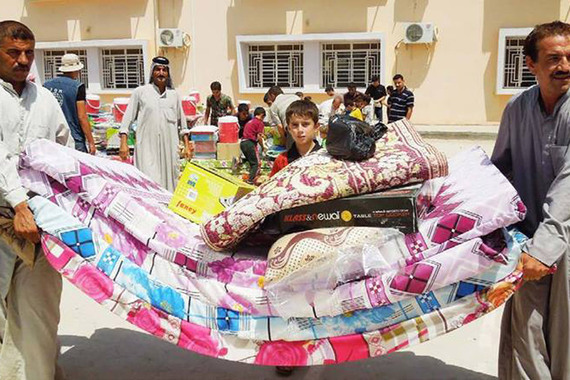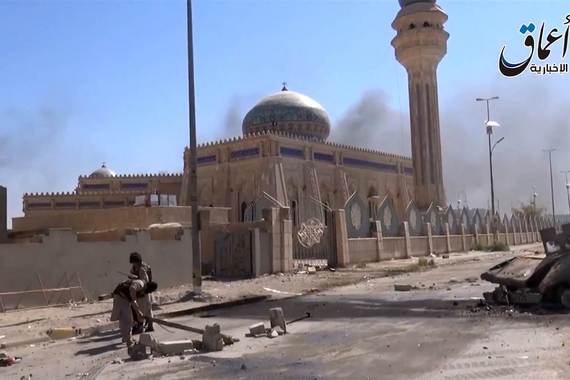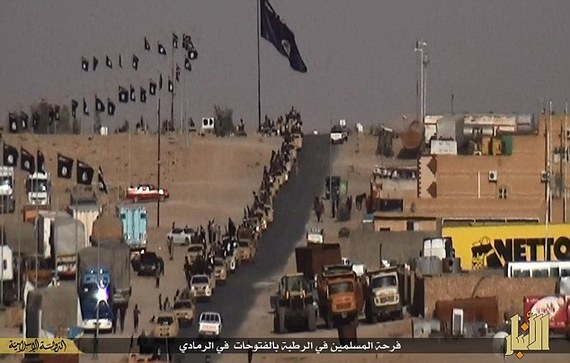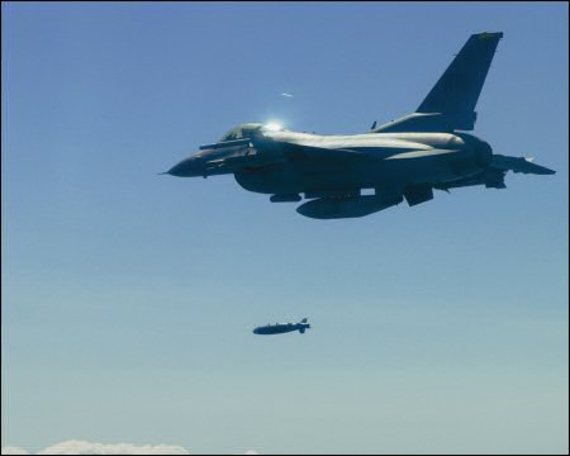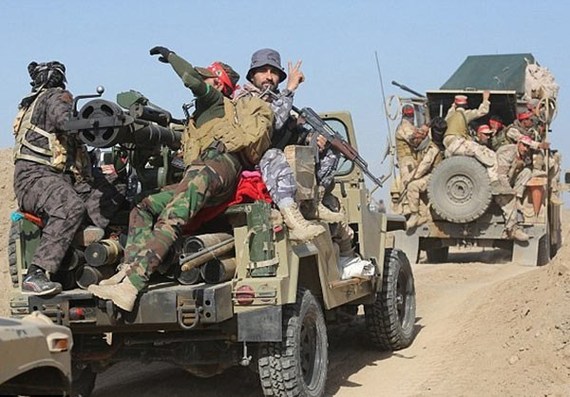On May 17, Islamic State militants seized the key Iraqi city of Ramadi. The capital of Anbar province, its population of around 800,000 inhabitants makes it second only to Mosul among the cities controlled by IS. The fall of Ramadi was a sharp reversal for the Iraqi government, coming only weeks after the successful capture of Tikrit from Islamic State militants, and cast new doubts on the effectiveness of the Baghdad government's ability to successfully roll back the Islamic State.
Criticism and blame was quick to follow. The governor of Anbar province blamed the central government in Baghdad for the lack of promised reinforcements. Government officials, off the record, blamed the lack of adequate American air support, citing the fact that only about 36 strikes were carried out by U.S. led coalition forces. The Pentagon blamed The Iraqi Army unwillingness to fight noting that ISIS forces were outnumbered 10 to 1. In the United States, pundits, most notably CNN's Fareed Zakaria, were quick to announce that Iraq had ceased to exist and that there was no one there willing to fight to preserve the country. In a remarkable twist, Iran Quds Force commanders and the Shiite militia allies claimed that it was the United States, through its lack of support, which had demonstrated an unwillingness to fight.
The truth as usual lies somewhere in the middle. First of all, the Battle for Ramadi has been going on since the winter of 2014. Control of large portions of the city have shifted back and forth between Islamic State militants and Iraqi government forces. Baghdad had managed to regain control of most of the city by May of 2014 only to steadily lose ground to IS forces over the summer and fall of 2014. By October 2014, IS claimed that it was in control of 60 percent of Ramadi and that in addition it controlled the approaches to Ramadi from the south, north and west of the city.
Fighting continued over the winter months with IS militant making slow but steady gains. On May 14, IS forces launched a new assault on the area still held by government forces using bulldozers that had been reinforced with steel plating as well as a series of 10 suicide car bombs, many using captured Humvee vehicles, to burst through the defensive ring around the center of the city. Heavy fighting continued till May 17, when the last government controlled neighborhood, Mal'ab, in the south of Ramadi fell.
While it is true that Iraqi forces outnumbered IS militants by a considerable margin, many of the Iraqi army forces were spread out through the region surrounding Ramadi in defensive positions. By the time the attack started, Islamic State already controlled about 80% of Ramadi. Moreover, the claim that the Iraqi Army refused to fight was not entirely fair. Observers on the ground did report that some Iraqi Army units fought tenaciously.
In particular, the First Brigade of the Iraqi Special Operations Forces, an American trained Special Forces unit nicknamed "The Golden Division" earned high praise from both American military observers and journalists embedded in the unit. Still, there is no question that other Iraqi Army units, in a pattern long since grown familiar, abandoned equipment and supplies and beat a hasty retreat. With the collapse of a defensive perimeter as a result of disorganized retreats even the most tenacious units have little option but to withdraw least they get outflanked and surrounded.
Criticism of the lack of U.S. air support also had some validity. Eric Schmitt, writing in the New York Times on May 26, quoted a number of American and Iraqi military officials expressing their concerns that the rule of engagement imposed on American pilots were so restrictive that important, obvious targets were being ignored for fear of collateral casualties to civilians. Senator John McCain, chairman of the Senate Armed Services Committee claims that only one in four missions actually result in a strike against an Islamic State target. The pace of air operations is also considered inadequate by observers on the ground.
Currently air operations average 15 missions over Iraq and Syria combined. In contrast, air operations during the intervention in Libya averaged 50 a day. Over Afghanistan in 2001, air missions averaged 85 daily. During the height of the war in Iraq in 2003, air operations numbered some 800 missions a day. The absence of American forward air controllers on the ground, the result of a deliberate White House decision not to deploy them, has also hampered the effectiveness of the air campaign. The criticism by the government in Baghdad, as well as from some of the Shite militias, that Washington is doing the absolute minimum in deploying air power against Islamic State has some merit.
At the moment, the Iraqi government finds itself engaged with Islamic State on two distinct fronts. For convenience's sake we can think of these as the Tigris River Valley Front and the Euphrates River Valley Front. The Tigris Front runs roughly north-south, from Mosul in the north through, Baiji, Tikrit, and Samarra to Baghdad and south to Basra where the Tigris river links up with the Euphrates. The Euphrates Front runs roughly northwest to southeast through Fallujah, Ramadi and the rest of Anbar province to Aleppo in Syria.
The Baghdad government has the ability to project significant force, to call if overwhelming is a bit charitable, in one front but not simultaneously in both. Advances on one front invariable bring Islamic State counterattacks on the second front. The fall of Tikrit, on the Tigris front, brought simultaneous IS counterattacks on Baiji, north of Tikrit and on Ramadi on the Euphrates front. The simultaneous attacks, characteristic of the nimbleness that IS has demonstrated in the war with Baghdad, resulted in pinning down significant Iraqi forces around Baiji that might otherwise been available to deploy in Ramadi.
Currently, Islamic State controls about 80 percent of Anbar province. It is clear that IS has placed a great deal of strategic value in controlling Anbar. This control allows it to maintain the road links between its territories in Syria and those in Iraq. Given the success of Kurdish forces in cutting off most of the road access between Mosul and Syria and their continued success in clearing the adjacent Kurdish zones in northern Syria from IS militants, the loss of Anbar would effectively split the Islamic state into two separate geographic zones. The Iraqi government has recognized the importance of regaining control of Anbar and has prioritized this campaign over retaking Mosul.
One of the dilemmas facing the Iraqi government is the fact that currently it has two armies, an American trained and equipped, official Iraqi Army and an Iranian Quds Force led, Shiite militia army. The regular Iraqi Army is currently at about half its designated strength of 14 divisions. The United States has been in the process of retraining and rebuilding the Iraqi Army. To date, the US has lavished some 25 billion dollars in training and equipment on the Iraqi Army and Baghdad has spent even more. As currently constituted it does not appear that the Iraqi army can muster enough strength to defend the country from Islamic State militants much less roll back their territorial gains.
Moreover, notwithstanding some notable exceptions, the effectiveness of the Iraqi army is in serious doubt. The Baghdad government used the Iraqi military as a giant slush fund to reward its supporters. At the time of the Islamic State's attack on Iraq, roughly a quarter of Iraq's army consisted of phantom soldiers; enlisted personnel drawing a paycheck of a few hundred dollars a month but otherwise permanently AWOL. Senior officer appointments were based on political loyalty to Iraq's leaders rather than military competence. Corruption in the Iraq military is rife and, not surprisingly, moral in the enlisted ranks is poor. Given those conditions, the lack of battlefield effectiveness by the Iraqi army will hardly come as a surprise.
The collapse of the Iraqi army over the summer of 2014 led the Iraqi government to mobilize Shiite militias in a desperate attempt to stop Islamic State militants from overrunning Baghdad. Trained and commanded in the field by Iranian Quds Force officers, these "Popular Mobilization" militias have proven themselves to be tenacious, though poorly disciplined, fighters. They played as key role in the recapture of Tikrit but were also implicated in a large number of revenge killings of Sunnis in Tikrit as well as widespread looting.
At some point the Iraqi government has to determine how these two armies will work together; indeed whether they even can work together. Given the record of Iraqi Army forces, it is unlikely that the Baghdad government will disband the Popular Mobilization Forces or that they even could if they wanted to. The use of these Shiite militias to fight Islamic State militants in predominantly Sunni Anbar province however further aggravates Sunni-Shia sectarian violence.
The Iraqi government has urged the remnants of the Sunni militias created during the Awakening Movement to join in the "liberation of Anbar", but it has refused to provide the Sunni militias with modern weapons. One military observer described much of the weaponry of the Sunni militias as "antiques" that belong in a military museum. In the meantime, Shiite paramilitary groups like Kata'ib Hezbollah, organizations that were implicated in hundreds of attacks against American personnel in Iraq between 2003 and 2008, are using Humvees and, in at least one instance, A1M2 Abrams tanks that were likely bought and paid for by American tax payers.
The campaign to retake Tikrit made it clear that American airpower and, in particular, precision munitions would play a critical role in rolling back Islamic State. The dilemma for the White House is that to improve the effectiveness of the air campaign it will have to loosen significantly the rule of engagement as well as deploy American forward air controllers on the ground. It will also have to significantly step up the pace of air operations.
Baring a renaissance in the Iraqi military however, an expanded air campaign would require a broader cooperation with Iranian led Shiite militias. Even if the deeply felt distrust between the American military and these militias could be overcome, the idea of becoming the air arm, much less embedding American forward air controllers, to militia groups that were directly responsible for hundreds of American deaths during the Iraqi war will generate a political firestorm in the United States.
However you approach the problems of rolling back Islamic State, there are no easy solutions and all of the tradeoffs are difficult ones. Following the fall of Ramadi, the Iraqi government announced confidently that the city would be recaptured within a matter of weeks. So far, a month has passed with little progress evident. Moreover, what currently appears to be a stalemate is in fact deceptive. The Iraqi government has been able to retake about 10 percent of the territory controlled by IS at the height of its expansion however Islamic State militants have more than compensated for that by expansion of their territory in Syria.
Moreover, during this period Islamic State has been able to organize "franchises" in some two dozen countries around the world. Even if its territorial expansion in Syria and Iraq is contained, no mean feat in its own right, its ability to expand, metastasize would be a more appropriate description, around the world will cause bigger, longer term problems for the United States and its allies.
The fact is, Kobani and Tikrit notwithstanding, on a worldwide basis, the United States is losing the war against Islamic State. The only thing worse than losing a war is losing it without even realizing it.


